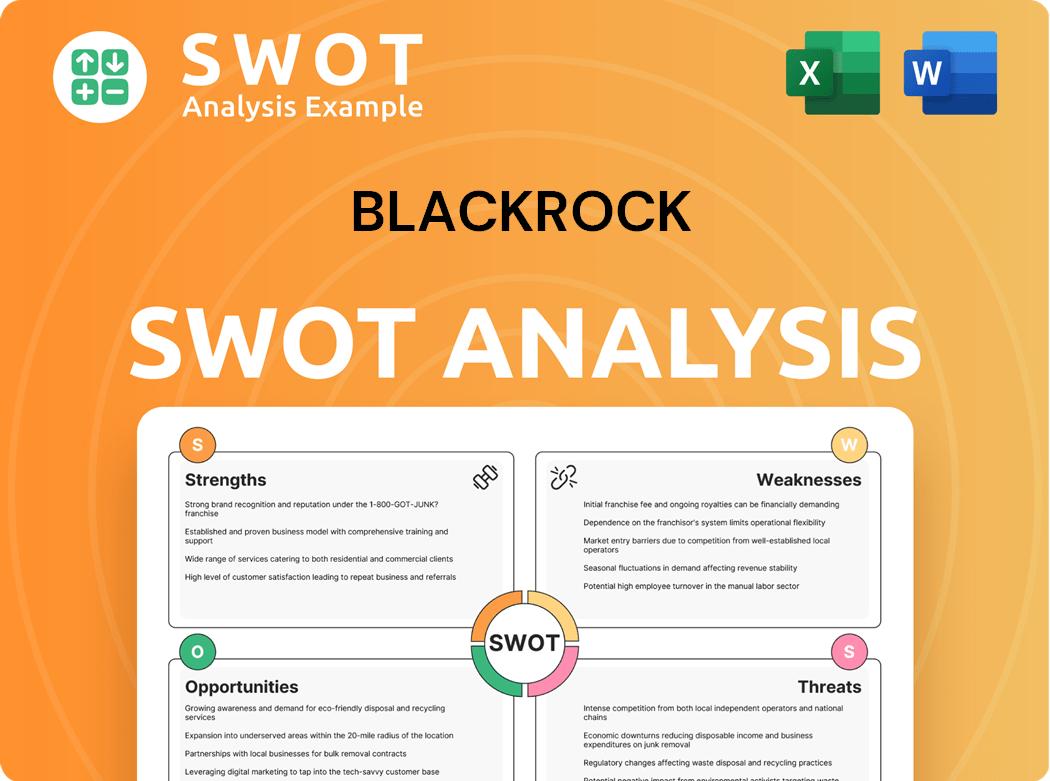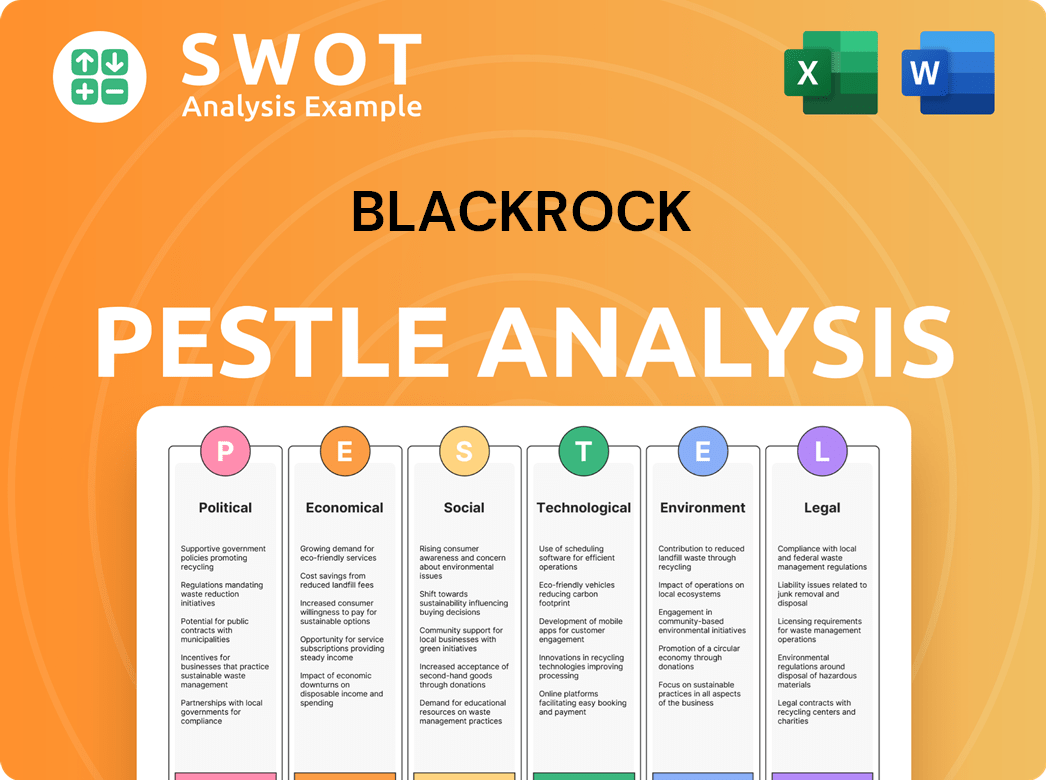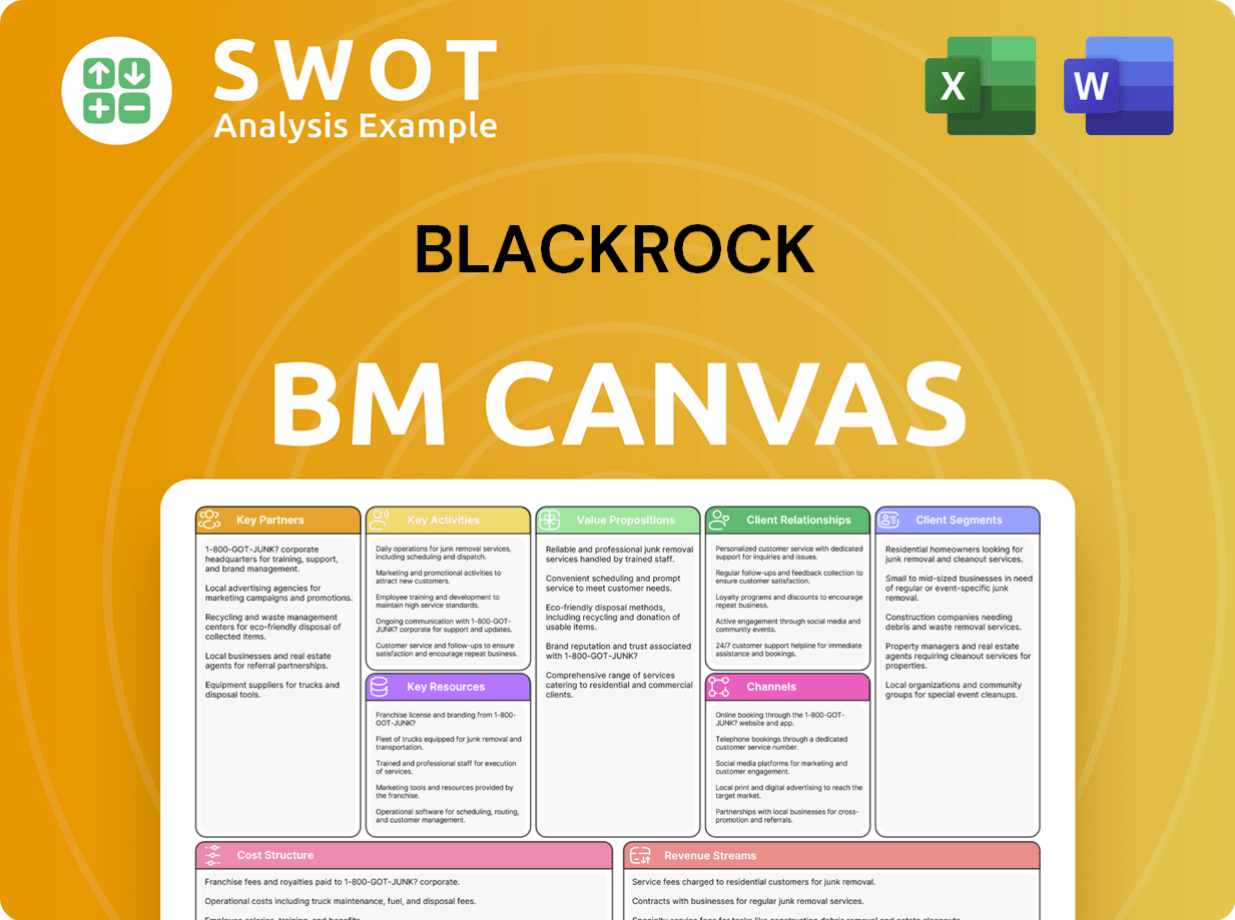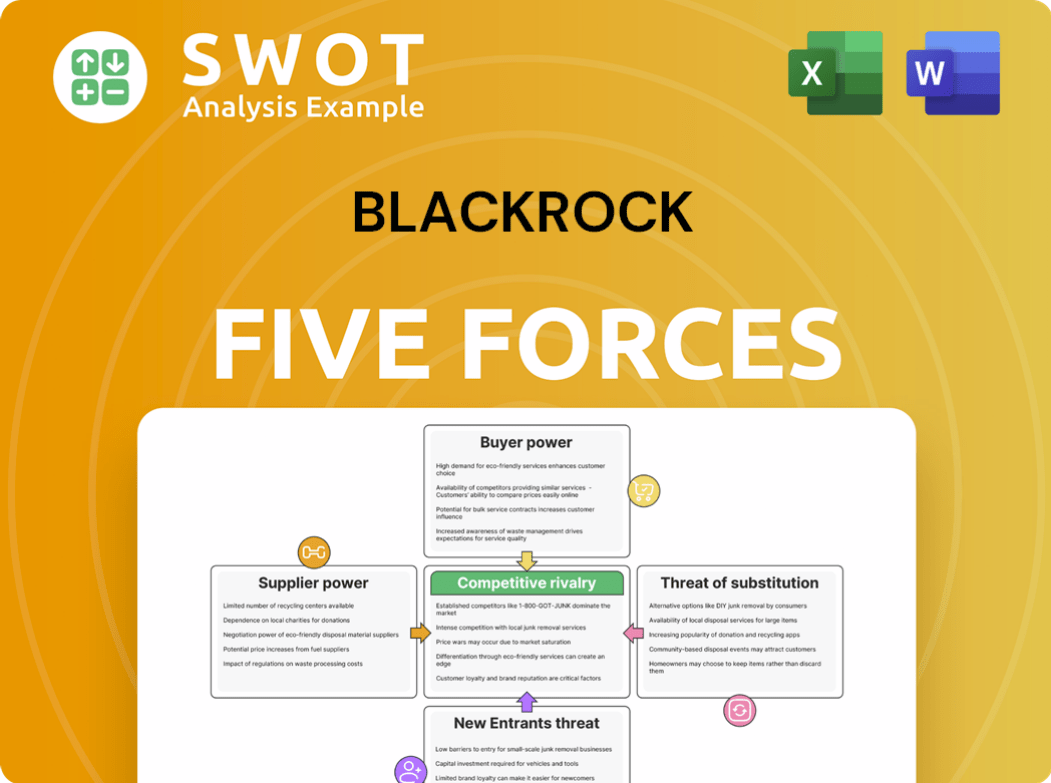BlackRock Bundle
How Does BlackRock Dominate the Asset Management Arena?
As the world's largest asset manager, BlackRock's strategic moves in early 2025, including its foray into the spot Bitcoin ETF market, are reshaping the financial landscape. Founded in 1988, BlackRock has evolved from a fixed-income specialist to a global powerhouse with trillions in assets. This evolution underscores its commitment to innovation and its ability to anticipate and capitalize on emerging market trends.

This deep dive into the BlackRock SWOT Analysis examines the company's competitive strategies and the key players in the asset management industry. We'll explore BlackRock's market share, its financial performance against competitors, and its strategies for maintaining dominance in the face of evolving challenges. Understanding the BlackRock competitive landscape is crucial for anyone seeking to navigate the complexities of the financial services sector.
Where Does BlackRock’ Stand in the Current Market?
BlackRock's market position in the global asset management industry is undeniably dominant. As of the first quarter of 2024, the company managed approximately $10.5 trillion in assets under management (AUM). This massive figure solidifies its status as the world's largest asset manager, significantly outpacing its closest rivals. The company's core operations revolve around providing a comprehensive suite of investment solutions.
These solutions span various asset classes, including equities, fixed income, alternatives, and money market instruments. BlackRock is particularly well-known for its iShares exchange-traded funds (ETFs), which represent a significant portion of its AUM and hold a leading market share in the global ETF landscape. The firm's value proposition centers on providing diverse investment products and sophisticated risk management through its proprietary technology platform, Aladdin.
BlackRock's global presence is extensive, serving clients across the Americas, EMEA (Europe, Middle East, and Africa), and Asia-Pacific. Its client base includes institutional investors like pension funds, endowments, foundations, and sovereign wealth funds, as well as retail investors. The company has strategically focused on digital transformation and diversification, exemplified by its investment in Aladdin, which is also licensed to other financial institutions. To understand more about the company's origins, you can read a Brief History of BlackRock.
In Q1 2024, BlackRock's revenue reached $4.73 billion, marking an 11% year-over-year increase. Diluted earnings per share (EPS) rose by 23% to $9.81. The firm's operating margin stood at 38.6% in Q1 2024, reflecting strong operational efficiency.
BlackRock holds a particularly strong position in the ETF market and in providing technology solutions through Aladdin. The company continuously seeks to expand its footprint in alternative investments and sustainable investing. This focus on innovation and diversification is a key competitive advantage.
BlackRock's global presence allows it to serve a diverse client base across multiple regions. This diversification helps mitigate risks associated with economic fluctuations in any single market. The company's ability to cater to both institutional and retail investors is a further strength.
BlackRock's strategic initiatives include a focus on digital transformation and diversification of offerings. Investments in technology, such as Aladdin, and expansion into alternative investments are key strategies. These efforts are aimed at maintaining market dominance and driving future growth.
BlackRock's competitive landscape is shaped by its position as the largest asset manager. Key players in the asset management industry include Vanguard, Fidelity, State Street, and others. These firms compete across various investment products and services.
- Vanguard is a major competitor, particularly in the ETF market, known for its low-cost index funds.
- Fidelity offers a wide range of investment products and services, including mutual funds and brokerage services.
- State Street is a significant player, especially in the institutional market, with its SPDR ETFs.
- Other investment firms, such as Amundi and Allianz Global Investors, also compete in the global asset management market.
BlackRock SWOT Analysis
- Complete SWOT Breakdown
- Fully Customizable
- Editable in Excel & Word
- Professional Formatting
- Investor-Ready Format

Who Are the Main Competitors Challenging BlackRock?
The BlackRock competitive landscape is shaped by a diverse range of rivals across various business lines. The firm faces intense competition in the asset management industry, with key players vying for market share and client assets. Understanding these competitors is crucial for analyzing BlackRock's position and strategies in the financial services sector.
The BlackRock market analysis reveals a dynamic environment where traditional asset managers, alternative investment firms, and emerging fintech companies all play significant roles. This competitive pressure influences BlackRock's strategic decisions, from product development to client service. The firm's ability to maintain its market leadership depends on its ability to adapt and innovate in response to these competitive challenges.
BlackRock's main rivals in 2024 include both direct and indirect competitors. The firm faces challenges from established asset managers, such as Vanguard and State Street Global Advisors, as well as from newer players in the fintech and digital asset spaces. These competitors employ various strategies, including low-cost offerings, specialized investment products, and technological innovation, to attract clients and gain market share.
Vanguard, known for its low-cost index funds and ETFs, directly challenges BlackRock's iShares franchise. State Street Global Advisors, particularly with its SPDR ETFs, competes for institutional mandates. Fidelity Investments also offers a growing suite of ETFs and institutional investment services.
Apollo Global Management and KKR offer specialized, higher-return alternative investment strategies. These firms compete with BlackRock by providing private equity, private credit, and real estate investment options.
JPMorgan Chase and Goldman Sachs have substantial asset management divisions. They compete with BlackRock for institutional and high-net-worth clients, leveraging their broader financial services offerings.
Robo-advisory services, such as Betterment and Wealthfront, indirectly compete by providing low-cost, automated investment solutions. Cryptocurrency investment platforms and digital asset managers also present new competition.
Vanguard reported approximately $8.6 trillion in global AUM as of year-end 2023, making it a significant competitor. The asset management industry is constantly reshaped by mergers and alliances, leading to larger, more diversified competitors.
Competitors employ strategies such as low-cost offerings, specialized products, and technological innovation. BlackRock's ability to maintain market leadership depends on its ability to adapt and innovate in response to these challenges.
The asset management industry is highly competitive, with firms constantly striving to gain market share. BlackRock's market share compared to competitors is a key indicator of its success. Understanding BlackRock's competitive threats and challenges is crucial for assessing its future prospects. For more insights into BlackRock's strategic direction, consider reading about the Growth Strategy of BlackRock.
Several factors influence the competitive landscape:
- Pricing: Low-cost offerings from Vanguard and others put pressure on BlackRock's fees.
- Product Innovation: The introduction of new ETFs, alternative investment products, and digital asset offerings.
- Distribution: The ability to reach and serve a diverse client base, including institutional and retail investors.
- Technology: The use of technology for investment management, client service, and operational efficiency.
- Brand Reputation: The strength of the brand and its ability to attract and retain clients.
BlackRock PESTLE Analysis
- Covers All 6 PESTLE Categories
- No Research Needed – Save Hours of Work
- Built by Experts, Trusted by Consultants
- Instant Download, Ready to Use
- 100% Editable, Fully Customizable

What Gives BlackRock a Competitive Edge Over Its Rivals?
The competitive landscape for asset management is fiercely contested, with firms vying for market share through various strategies. Evaluating the competitive advantages of BlackRock is crucial for understanding its position within the asset management industry. This involves analyzing its key strengths, strategic initiatives, and how it differentiates itself from its BlackRock competitors.
Understanding the competitive dynamics within the financial services sector is essential for investors and industry participants. BlackRock's approach to navigating this landscape, including its technological investments and product diversification, shapes its competitive edge. A thorough BlackRock market analysis reveals the firm's strengths and vulnerabilities, helping to assess its future prospects.
As of Q1 2024, BlackRock managed approximately $10.5 trillion in assets under management (AUM). This massive scale allows it to offer competitive fees and enhances its bargaining power within the financial ecosystem. Its strategic moves, such as the continuous development of its proprietary technology platform, Aladdin, have solidified its position as a leader in the global asset management market.
BlackRock's significant scale provides substantial economies of scale, leading to lower operating costs and the ability to offer competitive fees. This scale also gives it considerable bargaining power with brokers and market makers, improving trading efficiencies. Its vast AUM of approximately $10.5 trillion as of Q1 2024 demonstrates its dominance and financial strength, setting it apart from many BlackRock competitors.
Aladdin, BlackRock's proprietary technology platform, is a pivotal differentiator. This comprehensive system is used internally and licensed to over 200 institutional clients, providing sophisticated analytics, real-time risk assessments, and streamlined operations. The continuous investment in Aladdin ensures its relevance and superiority in the data-driven investment world, giving BlackRock a significant competitive advantage.
BlackRock's strong brand equity, built on a reputation for stability, expertise, and innovation, fosters strong client loyalty among institutional and retail investors. Its extensive global distribution network amplifies its reach and ability to attract and retain clients worldwide. This trust is built on years of consistent performance and a commitment to transparency and risk management.
The breadth and depth of BlackRock's product offerings, covering equities, fixed income, alternatives, and money market instruments across active and passive strategies, cater to a wide spectrum of investor needs. This diversification reduces reliance on any single asset class or investment style. This comprehensive approach helps BlackRock maintain its competitive position.
BlackRock's competitive advantages are rooted in its scale, technological innovation, brand reputation, and diversified product offerings. These strengths allow it to attract and retain a broad client base and maintain a leading position in the asset management industry. Understanding these advantages is critical for anyone analyzing the Marketing Strategy of BlackRock.
- Scale: Approximately $10.5 trillion in AUM as of Q1 2024, providing economies of scale.
- Technology: Proprietary platform Aladdin offering advanced analytics and risk management.
- Brand: Strong reputation for stability and expertise, fostering client loyalty.
- Product Diversification: Broad range of investment products across various asset classes.
BlackRock Business Model Canvas
- Complete 9-Block Business Model Canvas
- Effortlessly Communicate Your Business Strategy
- Investor-Ready BMC Format
- 100% Editable and Customizable
- Clear and Structured Layout

What Industry Trends Are Reshaping BlackRock’s Competitive Landscape?
The asset management industry is currently undergoing significant transformations, influencing the BlackRock competitive landscape. Key trends include the rise of passive investing, the growing demand for alternative assets, the integration of sustainable investing, and technological advancements. These factors present both challenges and opportunities for BlackRock and its competitors.
BlackRock's market analysis reveals a complex environment shaped by intense competition and evolving investor preferences. Understanding these dynamics is crucial for assessing the company's future prospects and strategic positioning within the financial services sector.
The asset management industry is seeing a surge in passive investing, particularly through ETFs. Alternative investments, such as private equity and real estate, are gaining popularity. ESG factors are becoming increasingly important to investors, driving demand for sustainable investment products. Technological innovation, including AI and blockchain, is rapidly changing the industry.
Intense competition from low-cost providers and specialized firms puts pressure on fees and market share. Regulatory changes concerning transparency and sustainability disclosures could increase operational costs. Geopolitical risks and economic volatility can impact market stability and investor confidence. Rapid advancements in AI and blockchain require continuous innovation.
Expanding into new markets, especially in Asia and emerging economies, offers significant growth potential. Developing innovative products, such as digital assets and personalized investment solutions, can attract new clients. Strategic partnerships and acquisitions in technology or specialized asset classes can strengthen market position. A focus on technology, diversification, and sustainable investing can drive future growth.
BlackRock is well-positioned to capitalize on the growth of passive investing with its iShares franchise. The firm is actively expanding its alternatives platform. It is integrating ESG considerations into its investment strategies and developing ESG-focused funds. BlackRock is investing heavily in technology, including its Aladdin platform.
The competitive landscape for BlackRock includes factors such as pricing, product innovation, and client service. Key BlackRock competitors, like Vanguard, compete on cost-effectiveness, while others focus on specialized investment strategies.
- Market Share: BlackRock held approximately $9.4 trillion in assets under management (AUM) as of December 31, 2023.
- Fee Pressure: The industry continues to see fee compression, with many firms lowering expense ratios to attract and retain clients.
- Product Innovation: The development of new investment products, including ETFs and alternative investments, is critical for attracting investors.
- Technology: Advancements in technology, such as AI and data analytics, are essential for improving investment strategies and client services.
BlackRock Porter's Five Forces Analysis
- Covers All 5 Competitive Forces in Detail
- Structured for Consultants, Students, and Founders
- 100% Editable in Microsoft Word & Excel
- Instant Digital Download – Use Immediately
- Compatible with Mac & PC – Fully Unlocked

Related Blogs
- What are Mission Vision & Core Values of BlackRock Company?
- What is Growth Strategy and Future Prospects of BlackRock Company?
- How Does BlackRock Company Work?
- What is Sales and Marketing Strategy of BlackRock Company?
- What is Brief History of BlackRock Company?
- Who Owns BlackRock Company?
- What is Customer Demographics and Target Market of BlackRock Company?
Disclaimer
All information, articles, and product details provided on this website are for general informational and educational purposes only. We do not claim any ownership over, nor do we intend to infringe upon, any trademarks, copyrights, logos, brand names, or other intellectual property mentioned or depicted on this site. Such intellectual property remains the property of its respective owners, and any references here are made solely for identification or informational purposes, without implying any affiliation, endorsement, or partnership.
We make no representations or warranties, express or implied, regarding the accuracy, completeness, or suitability of any content or products presented. Nothing on this website should be construed as legal, tax, investment, financial, medical, or other professional advice. In addition, no part of this site—including articles or product references—constitutes a solicitation, recommendation, endorsement, advertisement, or offer to buy or sell any securities, franchises, or other financial instruments, particularly in jurisdictions where such activity would be unlawful.
All content is of a general nature and may not address the specific circumstances of any individual or entity. It is not a substitute for professional advice or services. Any actions you take based on the information provided here are strictly at your own risk. You accept full responsibility for any decisions or outcomes arising from your use of this website and agree to release us from any liability in connection with your use of, or reliance upon, the content or products found herein.